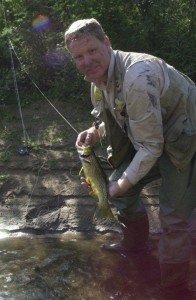Hopper Magic on the Bundara
It was late afternoon and we were only an hour from the Bundara River when the wind blew up and the high country hoppers began pelting our car windscreen.
The fate of the hapless hoppers notwithstanding, it was a welcome sight for a couple of dedicated fly fishermen. Like the first raindrops from a summer storm on a farmer’s windowpane, the soft staccato splatting of the hoppers foretold good things to come.
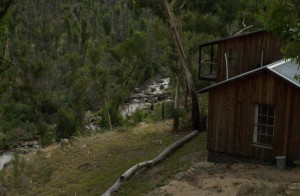 I had flown from Brisbane down to Melbourne that morning, to meet up with Frank Jones in Sale and the two of us planned to spend an autumn weekend catching up with old friends at Anglers Rest and dry fly fishing another old friend, the lovely Bundara River.
I had flown from Brisbane down to Melbourne that morning, to meet up with Frank Jones in Sale and the two of us planned to spend an autumn weekend catching up with old friends at Anglers Rest and dry fly fishing another old friend, the lovely Bundara River.
As we drove through the rising hopper clouds, thinning smoke clouds were drifting on a northerly breeze, down the Tambo River valley to our right, and we detected the unmistakable scent of burnt eucalypts.
We weren’t unduly alarmed, as we could soon see that this fire was by now clearly under control, but it rekindled memories of the havoc wreaked by the bushfires on Australia Day 2003, when a blaze from the top of the Bundara Valley took off and met up with a fire front moving down from Mount Hotham.
The fire destroyed all plant, animal and insect life in its path, right down to the water’s edge, and killed unknown numbers of fish.
Flames converged from three sides on the famous fly-fishing paradise of Anglers’ Rest, at the junctions of the Bundara, Cobungra and Mitta Mitta Rivers. The residents all survived, but many of their homes and huts, along with generations of precious memories were destroyed in minutes.
Melbourne engineer Donald Beveridge had single-handedly fought the flames to save his rural retreat, the Bundara Cabins. These cabins would be our home for the weekend.
Publican Graham Brown, with aide of some stranded road contractors, just managed to preserve the historic Blue Duck Hotel. This is where we would be eating our meal that night.
Graham’s brother Jim Brown was not so lucky and lost his home, which he had just finished building after five years’ hard work. Jim would be our genial barman for the weekend.
So, you can see, the bushfire of 2003 had left its scars on the residents of Anglers’ Rest and on the landscape. But the local residents are a tough bunch and they’d dusted themselves off, and got on with their lives. But what of the Bundara and its fish?
It was dusk by the time we arrived at Anglers’ Rest and pulled into Bundara Cabins. We were on the water within minutes and we were shocked at what we saw.
The fires had completely destroyed vegetation right up to the river’s edge, and subsequent flooding rains a few months earlier had washed tonnes of silt and sand from unprotected hills, into the water, and then on downstream, into the deeper holes, near our cabins.
What had once been deep holding pools, with snags and shadows to hide the trout, were now as little as a foot or so deep, with bright yellow or beige sandy bottoms, making it very difficult for the trout to find cover, or deeper cool water.
We didn’t have much time to think about this, as there was only about 15 minutes of light left and precious little moonlight to come, so Frank tied on a Royal Humpy and I used a large New Zealand Royal Wulff, which we cast into whatever shadows we could see on the darker side of the central feed lines.
We had three hits in quick succession and Frank hooked a small brown. By this time, the hoppers had well and truly disappeared, but clouds of small white caddis began hovering over the water, a good early sign for the health of the river.
Normally we would have ignored the dark, changed to a white Elk Hair Caddis, and fished up the river, but I’d been travelling for 12 hours by then, we couldn’t see the end of our rods in pitch darkness and neither of us were confident about the depth of the water, or the firmness under foot of the new silt base to the river, so we considered this to be an appropriate time to gather some intelligence from the locals.
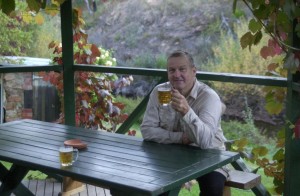 This is another way of saying we were tired and adjourned to the Blue Duck for a cold beer and some background gossip.
This is another way of saying we were tired and adjourned to the Blue Duck for a cold beer and some background gossip.
At the Blue Duck, the locals arrived in various states of somewhat informal attire, with retired army types and older hippies, joining the high plains horsemen, cow cockies and the occasional cattle dog sneaking in to curl up by the fire and gaze at the moths. Later the locals were joined by bankers, in carefully chosen checked flannel shirts trying to blend in, motor bikers in black leather breaking a long ride from Melbourne, and of course, fly fishermen from all over the world, drinking quietly and sub consciously noting the size and appearance of fellow patrons, the ebb and flow of customers around the tables, and the most popular order from the menu. We never relax.
So we enjoyed a cold beer and a magnificent home made beef and burgundy pie and talked with publican Graham Brown, local retiree Major Russell Smith and other locals, about the rehabilitation of the Bundara since the big fire.
The views on the fate of the Bundara differed. All agreed that the destruction of the canopy over the river had opened it to more terrestrial feed for the trout, and that the ash from the bushfires had cleared the Bundara far more quickly than it had on other rivers, including the Mitta Mitta.
Speculation was that this had brought some of the trout in from the Mitta, up the Bundara, about two years ago, but there was no consensus on the other life in the water and what impact the erosion of silt and sand into the river had had on the migrating trout and subsequent spawning. We’d soon find out.
The next day … hopper magic
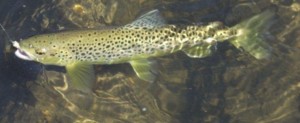 While Frank may be a dedicated fly fisherman he doesn’t believe in early starts, so we began at the Mitta Mitta River, near the junction with the Bundara, at about 9am. The air temperature was in the low 20s, the water was about 17 degrees, there was little wind, and only slight hopper movement on the banks.
While Frank may be a dedicated fly fisherman he doesn’t believe in early starts, so we began at the Mitta Mitta River, near the junction with the Bundara, at about 9am. The air temperature was in the low 20s, the water was about 17 degrees, there was little wind, and only slight hopper movement on the banks.
We then noticed a rise on the Bundara, a few metres up from where it joins the Mitta. In fact, it was the only rise we could see, so we followed it. I managed to spook this fellow with my first clumsy cast in a month, but we could see a nice pool, a little further upstream, so we tried it, as fly fishermen do. We had a plan, of course, but we couldn’t remember it.
The country was still pretty rough, but the water level was a lot lower than usual, and the silt and destruction of adjoining vegetation, had made the banks more accessible and the river itself a lot easier to wet wade. I was in polypropylenes, right in the water, while Frank fished from the side, in thigh waders.
Previously, when wading this stretch of the lower Bundara, in the deeper pools, I was used to putting the cork rod handle between my teeth and swimming for it, but the addition of several feet of silt, made the wading quite civilised, which was especially convenient for Frank, as he was carrying several thousand dollars worth of borrowed camera gear.
We experimented with a range of flies, while Frank checked out the marine ecology, finding plenty of caddis nymphs, tadpoles and frogs … in fact a lot more than usual. The signs were good, but where were the fish?
Then we saw the first signs of trout. But they ignored our polite entreaties and our wide range of flies on offer, and were holding station, wherever they could find a shadow, in little shallow pools, just off the bubble line, waiting for something better to drift along.
The dinner gong
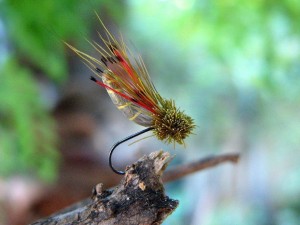 Then at 10am their morning tea arrived, in the form of a gentle breeze and a cloud of all types of hoppers, which, with no restraining vegetation on the bare banks, were falling into the water more readily than usual.
Then at 10am their morning tea arrived, in the form of a gentle breeze and a cloud of all types of hoppers, which, with no restraining vegetation on the bare banks, were falling into the water more readily than usual.
The breeze and accompanying hoppers were like a dinner gong in a boys’ boarding school, and the action was on. The trout were back, all right.
During the next six hours we caught and released 25 trout … almost all of them browns, as we waded the bottom one-third of the Bundara.
Frank had great success with a Bob and Betty Potts’ Franger Fly, so called because its fly line core, bound with different coloured strands of raffia, to simulate a hopper’s ribbed abdomen, is coated a final layer of condom rubber, to keep the fly light and totally dry and ‘floating proud in the water, higher than a honeymooner’s dick’, as Frank would say, and did, while he speculated aloud as to whether glow in the dark condom hoppers would work more effectively at night.
Unfortunately for Frank, after a couple of large brown trout had savaged his favourite Franger, the condom wrapper began leaking, and his fly started to droop sadly below the water’s surface film. He was obliged to change to a Dave’s Hopper, which also worked well, although it floated lower in the water and was harder to see when there was any glare on the surface.
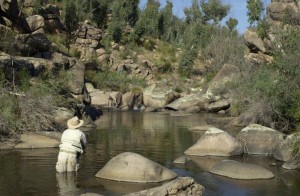 I used a pair of larger Knobby Hoppers, tied on size 7 or 8 long shanked hooks, about 30cms apart, with the end or point fly tied directly to the bend in the first hook. I tried to ensure equal weights between the two flies, or, if one was slightly heavier, the heavier fly went to the end. With similar weights and resistance in the two flies, it was surprisingly easy to cast, even on the end of a 15-foot leader.
I used a pair of larger Knobby Hoppers, tied on size 7 or 8 long shanked hooks, about 30cms apart, with the end or point fly tied directly to the bend in the first hook. I tried to ensure equal weights between the two flies, or, if one was slightly heavier, the heavier fly went to the end. With similar weights and resistance in the two flies, it was surprisingly easy to cast, even on the end of a 15-foot leader.
The first hopper had a bright yellow body and was tied with orange rubber legs and the second was chosen with either chartreuse or silver body, with a light coloured, high-floating deer haired knob, for maximum buoyancy and visibility over riffles, and the biggest and brightest red legs I could find.
The legs were a trifle academic, in any event, as greedy trout ate them off within a half hour or so, every time I changed them. When I ran out of flies, I simply sharpened the hook, fluffed up the tail, and went with what was left. So long as the outline survived, with a hint of yellow and red, or green, in the tail, the trout kept chomping. It was one of the best day’s fly fishing I’d ever had and I am looking at these two flies as I type. They are stuck in either end of a Grange Hermitage cork and blue tacked to the top of one of my computer screens. I get to see them every time I open an excel file and I’m reminded of that day on the beautiful Bundara.
 The main advantage of the double rig, over Frank’s single fly, seemed to be the splat or plopping sound of the dual rig hitting the water, and the promise of a decent feed from two largish hoppers, which, to a waiting trout, looked as tasty as a pair of speciality pies from the Bruthen Bakery. I found, on the trip up, that these are more enticing if one was filled with cauliflower, cheese and leek, and the other with lasagne. The trout, evidently, agreed with my reasoning.
The main advantage of the double rig, over Frank’s single fly, seemed to be the splat or plopping sound of the dual rig hitting the water, and the promise of a decent feed from two largish hoppers, which, to a waiting trout, looked as tasty as a pair of speciality pies from the Bruthen Bakery. I found, on the trip up, that these are more enticing if one was filled with cauliflower, cheese and leek, and the other with lasagne. The trout, evidently, agreed with my reasoning.
After some eight hours of serious wading and casting, without a break for lunch, by about 4pm I was starting to think even more about these Bruthen pies, and a cold beer at The Duck, when we reached the bank, below Bundara cabins.
Around this time, the wind dropped, the hoppers settled back into the grassy banks, a shower of snowflake caddis arrived and we decided to take stock, not long after I had unsuccessfully tried to wrestle a three pounder into my net for a final photo call, before release.
We’d seen plenty of nymphs, caddis, tadpoles, and frogs, not to mention the hoppers. And the 25 trout we’d hooked, ranged in size from about 18 one-pound trout, around a year old, up to about five or so two pounders around two years of age.
There were a few even bigger, around the three-pound mark. This ratio of size and age told us that a few young trout had in fact moved into the Bundara, after the fires, and had successfully spawned at least twice, to take advantage of an abundant supply of nutrition.
Fertility it seems had also been boosted by the initial intake of ash and nutrients and maintained for a second year. Hopefully this will extend to a third year, by which time the Bundara would have recovered sufficiently to provide more breeding stock for the Mitta Mitta and the Cobungra.
Following another night of exchanging information at the Duck, the next morning, we tried the middle section of the Bundara River, up from the Willows, run by Helen Packer, who hosts a local horse riding and fly fishing complex.
Unfortunately, Helen’s coffee was too addictive, and we only had an hour or two on the water before we had to head back to Melbourne, for what turned out to be a 13 hour commute home to Brisbane.
The middle sections of the river however, also yielded a good supply of one year old trout, but we had to depart before the wind brought on the hoppers.
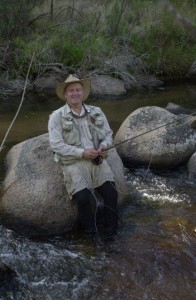 And again, this middle section of the river had been largely cleared of a covering canopy, the water was much shallower and lighter, because of the yellow-beige sand and silt, with a lot of snags and trout hiding spots cleared away. Despite this, the aquatic life was rich and varied, and the trout were back and breeding.
And again, this middle section of the river had been largely cleared of a covering canopy, the water was much shallower and lighter, because of the yellow-beige sand and silt, with a lot of snags and trout hiding spots cleared away. Despite this, the aquatic life was rich and varied, and the trout were back and breeding.
The bushfire of 2003 had indeed left its scars on the residents of Anglers’ Rest and on the landscape. But the trout, like the local residents, were a tough bunch and they’d dusted themselves off, and got on with their lives. Welcome back boys.
When you arrive at Anglers Rest, on the Omeo Highway, north of Omeo, you will see The Blue Duck Inn Hotel on the left and that pretty much is the CBD of Anglers Rest. There are no automatic tellers or petrol stations, so fill up in Omeo and bring lots of cash and a chequebook, although the Duck takes credit cards. The Duck overlooks the Cobungra River.
Drive just past the Duck and on an old wooden bridge over the Cobungra and you will see Callaghan’s Road, to the left. The Bundara Cabins are a short distance in, on the right, and The Willows, about 3 kilometres along, also on the right. Both are only a short walk from the Bundara.
Photographs by Frank Jones. Story originally published in FlyLife.
Our host for the weekend, Donald Beveridge can be contacted by email at
